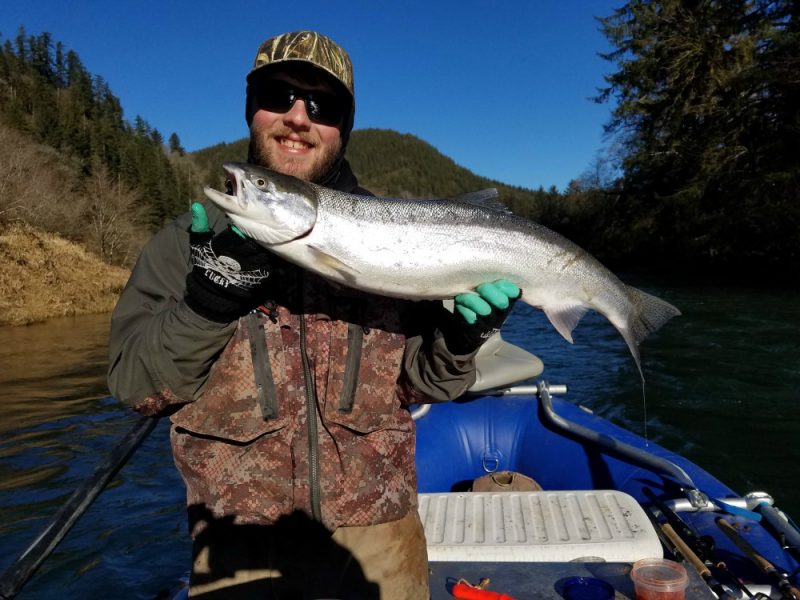Floating for Winter Steelhead in the Pacific Northwest
OutdoorHub Reporters 01.15.18
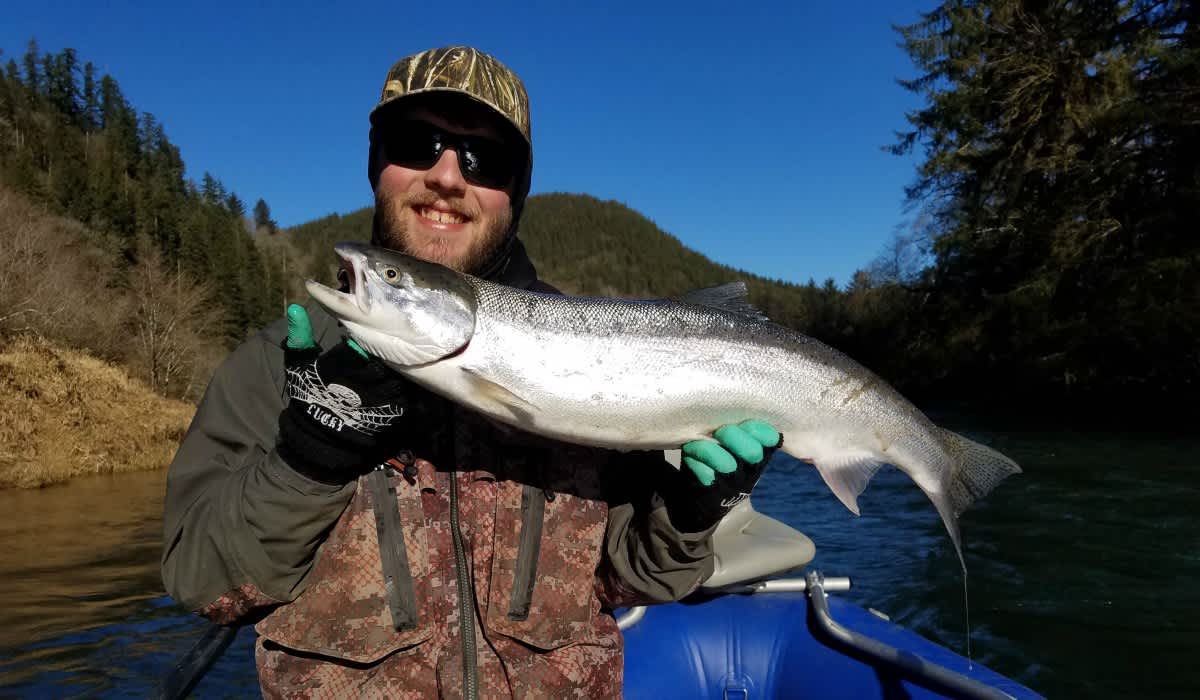
January 2017 was a brutal winter filled with storms that almost seemed to come and go in waves with the changing tides. Each one would pass through as the snow from the prior storm would just begin to melt. “The big one” hit Portland, Oregon, like Nolan Ryan tossing an over-sized snowball and taking out an unsuspecting toddler that never saw it coming. The metro area was crippled by the record snowfall, forcing anglers east of the coast range to sit out the thawing period while coastal rivers were dropping into shape.
Fortunately, the storm landed just north of me. On the 11th, Jacob Mikoleit (photo above) called me up from Newport to head up the 101 in search of winter steelhead. On our drive up the coastline just prior to daylight, the full moon reflected off a calm ocean filled with commercial crab boats running through the night.
Jake wanted to drop into the Nestucca for a float while the crowds were thin and fish were thick. Temperatures just below freezing combined with the heavy snowfall to the east of Tillamook deterred a lot of out-of-town traffic and limited the boat traffic to a couple local guides that were still pretty spread out.
At first light, the boat below us hooked a fish at Foland Creek just as we were pulling away from the ramp. Soon after, as we were floating through a bend in the river, there were two big submerged boulders that disrupted the flow of water perfectly for a resting area where I hooked into the first fish of the day. As the line tightened with the hookset, the fish tailwalked like a marlin, then deathrolled like a Nile crocodile before saying “See ya later alligator” and took off downstream before popping the hook loose. It was a rude awakening for both myself and the fish that early in the morning, but there was a lot of water ahead of us. The next day I landed a small wild fish in the same spot that was probably around 20 inches.
As we neared Beaver Creek, Jake told me to cast behind the boat as we went by and hit the seam between the creek and the river. As the float hit the water, he was directing me where we would target fish downstream. Looking the opposite direction of my float, I turned around to notice it wasn’t above water. I gave it a light tug to see if I was caught in an eddy or on the gravel, when I felt something gradually begin to give way and felt the slow headshake of a nice chrome buck.
The fish must have held onto that bead for a while, which I attribute to Pro-Cure’s Anise Bloody Tuna Super Gel. I don’t know how much time actually passed between the fish taking the bead and me finally setting the hook, but it didn’t seem to notice anything with the first few seconds of pressure, giving me enough time realize what was going on and bury the hook home.
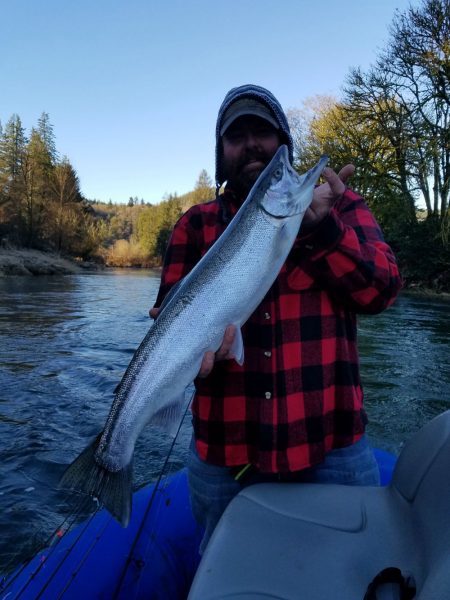
After a good fight, the fish came right to the boat, and Jake was there with the net. In the middle of the mayhem of untangling, unhooking, bonking, bleeding and tagging the steelhead, Jake noticed another fish roll. He quickly got a small pink worm on a blue jighead into the water while I was doing my paperwork. A feisty hen drained the bobber, and as Jake set the hook. It was almost as if he turned the fish on a dime and brought it racing towards the bow faster than he could pick up line. As the line got tight again, the fish put on an acrobatic display that would have put Mary Lou Retton to shame. I steadied the net as Mikoleit said, “Hold on, she’s probably going to freak out again.” Much like Olympic gymnasts, it seems like the smaller they are, the more flips and somersaults they can do. Finally, we tricked the fish into the net and started moving downstream in search of the next one.
Just downstream of the same area, I hooked a bruiser of a buck as we were about to drift through an area that’s split into three routes. While we had been moving toward the center chute, the fish made it perfectly clear it wanted to go clear across to the bank, peeling drag to the starboard side. This redirected Jake’s course at the last moment through a long set of riffles with little opportunity in the current to anchor up until we reached the end of the island.
Keeping pressure on the fish, we went for a ride, nearly a hundred yards or so free-drifting along with it. The fish seemed as if it couldn’t decide if it wanted to sit in the slack water to our left and be towed, or keep pace with the boat in the current. The few runs it made underneath the raft during this time were a memorable experience as Jake calmly rowed downstream to a point where we could get out and net the fish on the island. By that point, all of us were tired from the battle, but exhaustion had taken its toll on the fish. With our adrenaline still in high gear, it accepted defeat and submitted to the net.
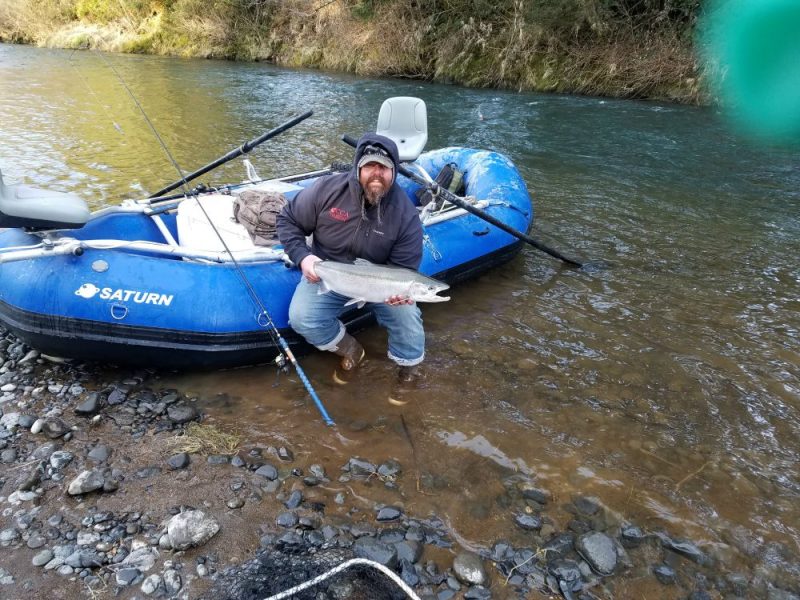
Even as the sun started to get above the trees, the temperature was still in the twenties. Line freezing in the guides made fishing a challenge all morning, and as we continued to drift downstream. Finding a patch of sunlight to warm ourselves started to take priority over finding more fish. As we nestled into a decent drift where we could catch some rays, we dropped anchor and he began to offer a buffet of presentations to the hole on the port side of the raft.
After fishing with Jake on several occasions, one of the things I admire most about his fishing style is his determination and the versatility of his presentations. I personally tend to get locked into fishing a bead under a float, and as effective as that may be, I have a difficult time thinking outside that box, even when the tactic isn’t working anymore. It’s educational at times seeing Jake bat cleanup and hit home runs on a regular basis throwing everything but the kitchen sink at the fish.
After fishing beads for a good 10 or 15 minutes with no expectations other than to warm our fingers and toes while anchored in that sunny bend in the river, Jake switched to something like a bobber dogging setup with a yarnie and prawn with a bead leader tied to the hook. When that didn’t work, he tried the pink worm again. When that didn’t work, he tossed one of his homemade spinners upstream a couple times, running it through the hole like a wrecking ball. Then he took a few casts 45 degrees from the boat and swung the spinner below us.

“I don’t think anybody’s home,” I said. “ . . . but I like this spot anyway. It’s sunny.” Finally, Jake pulled out a rod rigged up for float fishing bait, with a very small piece of hollowcore on the leader that slides down to get the bait into position. “There’s still one part of that seam I haven’t combed over really well because of the way those cross-currents meet,” he said.
While his preferred method of fishing is prawn-tipped jigs, the weighted glob of eggs seemed like a good way for the bait to get into the zone and make itself known in the steelhead green abyss. After getting the drift he wanted, the bobber did a stutter drop and he must have pulled back just as the fish let go because all the rigging came flying back at us. “I got something for ya,” he said while adding a fresh bait. After adding a few drops of ProCure’s Squid Oil to a fresh bait of eggs, he launched them back into position, and went right over where the fish bit the first time, but nothing happened. As he extended his drift another 15 or 20 feet, the bobber drained and line started peeling off the reel.
A good 7 or 8 minutes into the fight, we still hadn’t seen the fish or gotten much line back, and were beginning to wonder if maybe a late-fall chinook had taken a liking to the eggs. Then we finally got the egg-wagoneer within sight, but she didn’t come in easy. Using the boat as a break in the current, she camped out underneath the bow, doing everything that gets most lunkers back to freedom. After a few tries getting the fish within netting distance, I leaned out over the bow and in some miracle of a Stretch Armstrong Go-go-gadget yoga pose, managed to get the fish into the net and lift the hefty hen from the water.
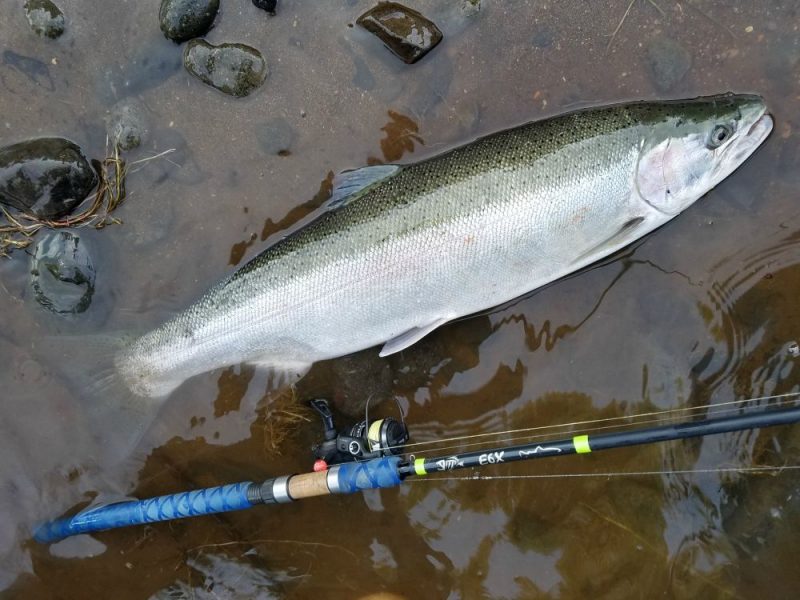
After tagging his limit in a hole we had spent over a half-hour fishing a half-dozen presentations, Jake made it clear once again that stepping outside the box is an effective method of putting fish into the box. Don’t be afraid to step outside your comfort zone and give the fish a buffet of options to choose from. You’ll be surprised how some winter steelhead are picky eaters, and increase your chances of hooking more fish.
